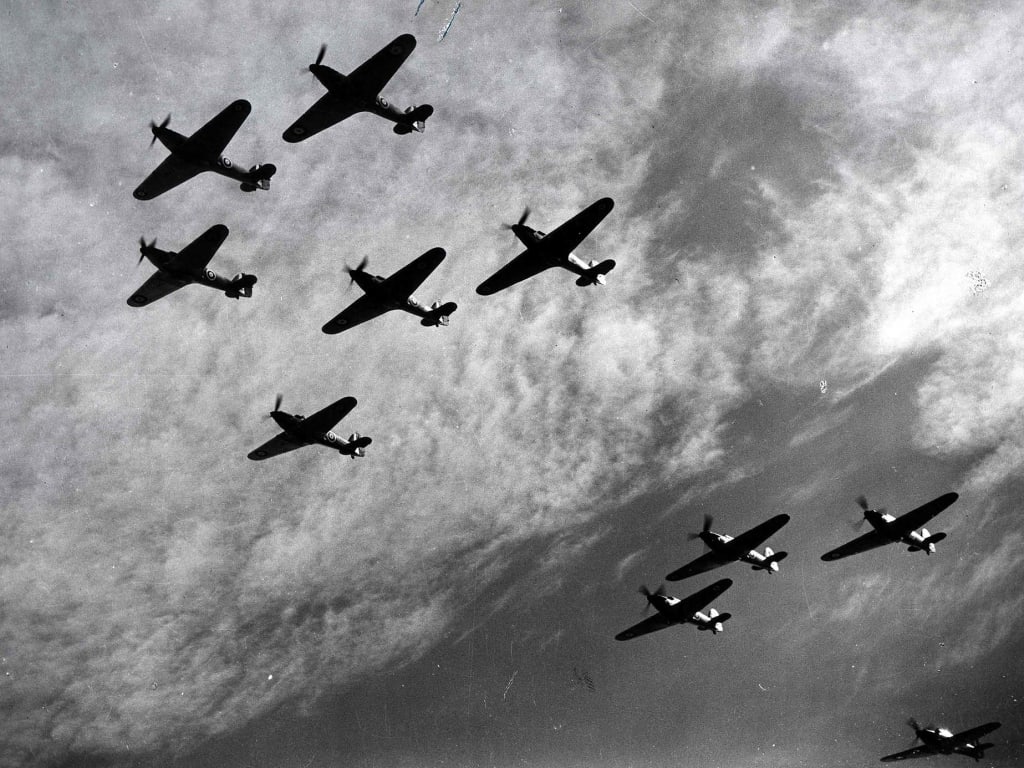10 Wild World War II Stories You Never Read About
From the tale of how a single Allied soldier captured Nazis by shouting at them to the stories of secret Nazi bunkers in the South Pole, these wild World War II stories will make you rethink your history knowledge.

World War II history reads a lot like an action-adventure story. There are bad guys, good guys, a fight to help save people from genocide, and tons of amazing tales of intrigue, espionage, and valiant acts during war.
For many historians, World War II was one of the very few times in human history that always remain a great read—not to mention a warning of what happens when good people stay silent. Finding books about World War II is a cinch, as the stories about this war and its people can be found around every corner.
However, there are certain World War II stories that seem so outlandish, so surreal, that they often aren't really discussed. These are 10 of those stories.
Conspiracy theorists will often discuss how Nazis had an Arctic base that hid top secret plans. Believe it or not, this was actually historical fact. Hitler wanted to have a base in the Arctic to house and create nuclear weaponry during the war.
The Arctic base housed around 3,000 soldiers and carried major secrets of Germany during the war. The reason why you don't really hear about the base in history books deals with one of the most hilariously bad war stories out there: it only took about a dozen Allied soldiers to take down their base!
In 1943's Operation Gunnerside, 11 Norweigian soldiers planted bombs inside the Nazis' secret Arctic base. The bombs immediately went off in key positions, destroying any chance of Nazis actually being able to make nukes.
The mission was successful and Germans quickly noticed the fleeing soldiers. Hilariously enough, one of the fleeing soldiers refused to leave until they found their glasses. Even though the mission was held up by that, all 11 soldiers survived the mission.
Hermann Goering was one of the most notorious World War II figures in history, and was regularly cited as a right-hand man to Adolf Hitler himself. Not many people could say that they were as closely aligned to Nazism as he could, but there was one thing that Goering didn't want anyone to know.
His brother, Albert Goering, was nowhere near as supportive of Hitler as he was. In fact, his brother was one of the most vocal anti-Nazi political players in Germany and joined the resistance almost immediately.
When Hitler rose to power, Albert fled to Austria and started to help save Jews from extermination by handing out visas. He was even known for confronting Nazis who were humiliating Jewish people—an act that would often cause people to get killed.
Despite all the moves Albert made, he was never killed. His brother couldn't bear to see him die and chose to have the Gestapo steered away from his area as a result. Albert even managed to convince Goering to free Jews in concentration camps because they were "good Jews."
Sadly, his brother's notoriety ended up causing Albert's downfall after the war. No one wanted to employ him and he died penniless, helped only by the very people he saved. Such is what happens when you share a name with one of the most feared war criminals in history.
If there's one thing that artists were fond of doing, it was trolling Nazis after Hitler basically banned artwork after citing it to be dangerous. One art dealer by the name of Han Van Meegeren might have trolled Goering harder than most others, though.
One of the little-known facts about WWII's aftermath most people don't know is that art dealers who were caught selling to Nazis were often given a death penalty. It was considered to be a form of blood-money laundering, and a sign of disrespect for the dead.
In 1945, Han Van Meegeren was arrested for selling a priceless Vermeer painting to Goering. He was supposed to be sentenced to death for the act. However, Van Meegeren ended up confessing to something way wilder than his original charge.
Van Meegeren claimed that the Vermeer was a fake, and that he painted it himself! After the painting was created, he bribed other appraisers to verify it—and even went so far as to paint another painting just like it to prove his innocence.
Though he died in prison, it seems like the good guys got the last laugh. It's fairly certain that Hermann Goering ended up paying a fortune for a fake painting that was done by a disgruntled art dealer.
When most doctors take the Hippocratic Oath, they tend to be a little casual about it. They may talk about denying service due to personal beliefs or may just view it as a job. But, for two medics in Angoville-Au-Plain, it was a serious calling.
It was D-Day, and the entire town was embroiled in a skirmish that would decide whether the town belonged to France or Germany. As villagers, soldiers, and resistors battled, the two medics became the only people in town with any medical knowledge in town.
They toiled day and night, treating all soldiers, villagers, and innocents alike. After the battle was done, the two had saved about 80 people. The town of Angoville-Au-Plain honored them both with a stained glass church window.
The two men lived long, happy lives afterwards and were universally respected for keeping their oath.
With World War II, you kind of have to expect to hear about casualties; it's the nature of war. Most people tend to think of casualties as people, but in the case of Oradour-Sur-Glane, this casualty makes you realize that it's not only people that die.
Many towns were ravaged by battles, but the horrors that the French village of Oradour-Sur-Glane saw paled in comparison to most. The vast majority of the village locals perished at the hands of Nazis as a revenge for the killing of a high Nazi official.
People were tortured, burned alive, and homes were instantly destroyed in what could only be called pure carnage. There were almost no survivors, and even Nazi officials protested the attack claiming that it was too brutal.
At the end of the war, President Charles de Gaulle declared that the village would not be restored as a way to remind the world of the atrocities of Nazis for the remainder of history. And so, the town of Oradour-Sur-Glane died, forever a symbol of the wreckage of war.
It has long been tradition to have musicians as part of armies, but you never really hear about World War II stories involving them. However, the 15th Lord Lovat, Simon Fraser, was a bit different than most. He was the kind of soldier that didn't dress in uniform, preferred turtlenecks, and had a sword at his side. You know, because he was probably not all there.
Fraser was given control of a bunch of troops, as he was a Lord and it seemed fit. He decided to tell his bagpipe player, Bill Millin, go to the front of the lines, and continue to play the pipes while ignoring all the killing and/or horrific screams around him.
Bill Millin did just that, and Fraser loved it. In fact, he loved it so much that he started killing Nazis left and right to the music. Fraser continued to request songs, and Millin continued to play song after song. We imagine it was like watching a Dungeons & Dragons bard fight in real life.
Despite all the bagpipe playing, German soldiers didn't really bother trying to shoot Millin. At one point, Millin asked one captive soldier why he didn't put a bullet in him. The soldier rightfully replied, "Because we all assumed you had just lost your mind."
You might think that Millin resented playing the bagpipes during the war, but you'd be dead wrong. Millin was so happy about his war experience, he played the pipes at the Lord's funeral in 1995—showing that they became friends forever.
Hans Scharff was the type of guy who just really didn't "do" war. He wasn't aggressive, disliked violence with a passion, and just didn't fare well with arguments. Through a long series of coincidences, he ended up being assigned to be a chief interrogator for the Nazi party instead of hitting the front lines.
Now, with most war stories you'd expect to hear, this would probably be the point where Scharff would do something evil or vicious and turn into a brutal interrogator.
However, Scharff wasn't that type of person. At all. Rather, he ended up being a very gentle interrogator who just listened to people when they spoke. The results he got, though, were shockingly good.
In recent years, United States scientists studied Scharff's techniques and discovered that his interrogation methods actually work better than the rough techniques that were traditionally used by German soldiers at the time. More impressively, people who are interrogated using this method are also less likely to notice how much information they are revealing.
Imagine being a patriot who is so passionate about fighting German soldier that you lie about your age just so you can fight. Rumors have often swirled about boys as young as 16 enlisting in the Army and Navy during World War II, but even they were pretty adult compared to the youngest enlisted soldier.
Calvin Graham pulled a "Captain America" style move when he enlisted in the US Navy during World War II. After he served and helped win the war, it was discovered that Graham was only 12 when he first signed up.
There were plenty of child soldiers in World War II on the German army and Russian army branches as well. Surprising as it is, that means that there are still quite a few World War II vets who are in their 80s around the world.
If you were around after 9/11, you may remember that France disliked the idea of going to war in the Middle East. In retaliation, many restaurants and individuals stopped calling french fries by their name and started calling them "Freedom Fries," which totally ignores that "frenching" is a term used for cutting food.
Believe it or not, this isn't the only time that Americans have pulled this kind of stunt. After the attack on Pearl Harbor and the declaration of war against Germany, Americans called hamburgers "Liberty Burgers" as a way to avoid sounding German.
Go figure.
Many World War II stories involve the discussion of concentration camps and the atrocities people faced while there. It's very easy to assume that concentration camp prisoners didn't really have much spirit left in them after seeing people die every day, but that's just not true.
In 1943, Germany's losses started to make the news among circles in concentration camps—including a camp known as Treblinka. Prisoners began to wonder if Germans were going to exterminate all of them in order to hide the genocide they made, and they weren't going to take it lying down.
A group of Jewish prisoners called "The Operating Committee" planned and staged a revolt against the prison guards. They set fire to the camp's storage facilities, attacked guards, and successfully tore open a fence. Around 300 prisoners escaped the camp, with 100 of them surviving the SS.
One of the Operating Committee's leaders wrote a book about his uprising, and it's arguably one of the best books on war everyone should read.
About the Creator
Skunk Uzeki
Skunk Uzeki is an androgynous pothead and a hard partier. When they aren't drinking and causing trouble, they're writing articles about the fun times they have.






Comments
There are no comments for this story
Be the first to respond and start the conversation.